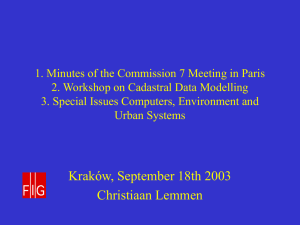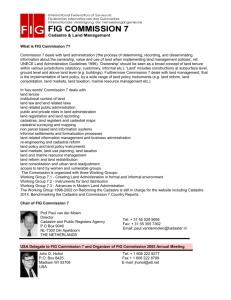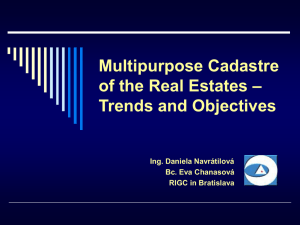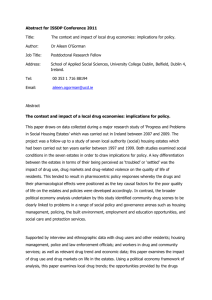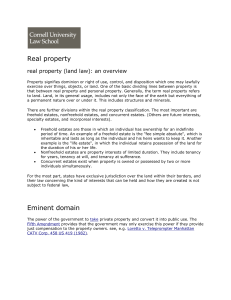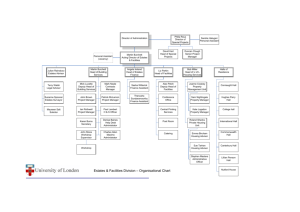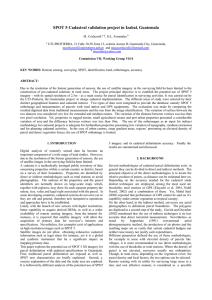Urban Cadastral Database Modelling Leira CHACÓN and Domingo HERNÁNDEZ Engineering Faculty.
advertisement
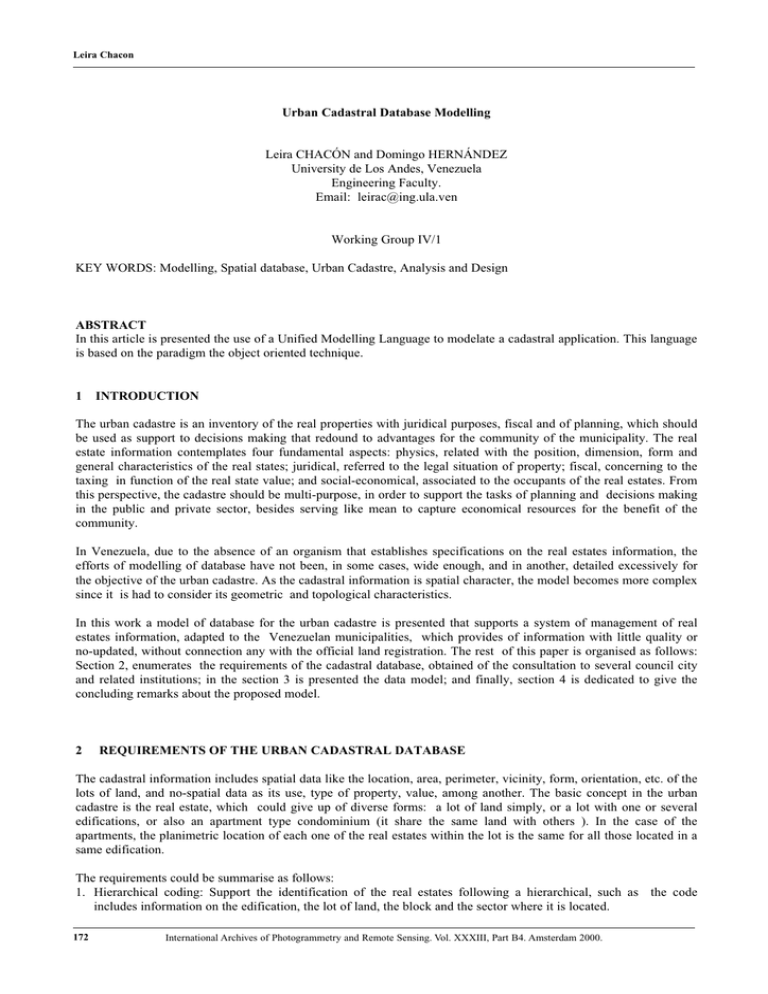
Leira Chacon Urban Cadastral Database Modelling Leira CHACÓN and Domingo HERNÁNDEZ University de Los Andes, Venezuela Engineering Faculty. Email: leirac@ing.ula.ven Working Group IV/1 KEY WORDS: Modelling, Spatial database, Urban Cadastre, Analysis and Design ABSTRACT In this article is presented the use of a Unified Modelling Language to modelate a cadastral application. This language is based on the paradigm the object oriented technique. 1 INTRODUCTION The urban cadastre is an inventory of the real properties with juridical purposes, fiscal and of planning, which should be used as support to decisions making that redound to advantages for the community of the municipality. The real estate information contemplates four fundamental aspects: physics, related with the position, dimension, form and general characteristics of the real states; juridical, referred to the legal situation of property; fiscal, concerning to the taxing in function of the real state value; and social-economical, associated to the occupants of the real estates. From this perspective, the cadastre should be multi-purpose, in order to support the tasks of planning and decisions making in the public and private sector, besides serving like mean to capture economical resources for the benefit of the community. In Venezuela, due to the absence of an organism that establishes specifications on the real estates information, the efforts of modelling of database have not been, in some cases, wide enough, and in another, detailed excessively for the objective of the urban cadastre. As the cadastral information is spatial character, the model becomes more complex since it is had to consider its geometric and topological characteristics. In this work a model of database for the urban cadastre is presented that supports a system of management of real estates information, adapted to the Venezuelan municipalities, which provides of information with little quality or no-updated, without connection any with the official land registration. The rest of this paper is organised as follows: Section 2, enumerates the requirements of the cadastral database, obtained of the consultation to several council city and related institutions; in the section 3 is presented the data model; and finally, section 4 is dedicated to give the concluding remarks about the proposed model. 2 REQUIREMENTS OF THE URBAN CADASTRAL DATABASE The cadastral information includes spatial data like the location, area, perimeter, vicinity, form, orientation, etc. of the lots of land, and no-spatial data as its use, type of property, value, among another. The basic concept in the urban cadastre is the real estate, which could give up of diverse forms: a lot of land simply, or a lot with one or several edifications, or also an apartment type condominium (it share the same land with others ). In the case of the apartments, the planimetric location of each one of the real estates within the lot is the same for all those located in a same edification. The requirements could be summarise as follows: 1. Hierarchical coding: Support the identification of the real estates following a hierarchical, such as the code includes information on the edification, the lot of land, the block and the sector where it is located. 172 International Archives of Photogrammetry and Remote Sensing. Vol. XXXIII, Part B4. Amsterdam 2000. Leira Chacon 2. Spatial information and no-spatial of the real estates: Permit the storage and processing of information related to the spatial characteristics of the lots and edifications like dimension, form, area, and no-spatial like the attributes of the owner and the occupants, use, value, public services, construction characteristic of the real estates, among others. 3. Spatial information and no-spatial of the sectors of the city: Including information on the public services, nets of streets, unit values of the land. The public services and the unit values of the land meet to street level, of such form that they associate to the real estates located in a determined street, allowing to know the services that they have and their unit values. 4. Tradition of the real estates: The historic information such as use, value, social-economical data of the people occupants, area, limits, co-ordinates of vertexes, etc., is important for legal and of planning ends. 5. Permissions of construction: Support the relative to the permissions of construction, modification or demolish of real estates in order to control this activity and make to complete the established urban norms. This will allow detecting the change on the characteristics of edification, which will serve for the updating of the real estate value. 6. Data input flexibility. The data could obtained from several sources like air photographs, air-photogrammetric and topographical surveying, existent plans, census . 7. Robustness 8. Extensibility 9. Security and privacy 3 SEMANTIC CADASTRAL DATABASE The semantic modelling of the data was carried out using the Unify Modelling Language (UML) of Rumbaugh (et al, 1991). UML is the successor of the methods of analysis and design oriented to objects. It unifies the methods of Rumbaugh (OMT) and Jacobson. UML is a graphic notation language for modelling oriented to objects which could be utilised both in the analysis and design. The methodologies are compound of a modelling language which is utilised to represent the design and the processes involved in the application domain. The purpose of the design is to decide how the system will be constructed. The modelling language is an important part of a methodology for software development because of allows the communication among the actors. UML is not considered a method, but a modelling language utilised by a method. The UML is based on diagrams to express and design the application. There are diagrams to represent the structure, the behaviour, the sequence of events, the cases of use, the collaboration, the activities, the implementation, etc. The figure 1 shows an example of class diagram using UML notation Is a Formed by Line Polygon Sector Has a Service Urban Block Street Value of the terrain Ubicate in Ubicate in Lot Value of Construction Construction Has Has Has Owner Has Real estate Ocuppant Juridical Tradition Figure 1. Class diagram for cadastral application International Archives of Photogrammetry and Remote Sensing. Vol. XXXIII, Part B4. Amsterdam 2000. 173 Leira Chacon Since in the field of the cadastre are required large representation scales, the vector model for the spatial data is the most adequate in order to achieve the required exactness, both in the obtaining of the areas and dimension of the lots of land, fundamental aspects for the valuation of the real estates, and in their cartographic representation. The vector model is based on the representation of the spatial objects through the basic geometric elements like point, line and polygon [Laurini and Thompson, 1992]. The spatial information of the cadastral database includes the limits of the parcels, edifications, blocks and sectors, street nets, drainage net, altitude. The no-spatial information includes data on the proprietors and occupants of the real estates, tradition, and permissions of construction. 4 CONCLUSIONS The cadastral database model is complete and permits to manage the spatial and no-spatial information of the real estates, supporting the control, planning and decision making process in the urban scope. REFERENCES Dobner H. K. Catastro: Concepto, Técnicas, Avances, Sistemas y Aplicaciones. Editorial Concepto S.A., México, 1981.. Pp 39-53 Rumbaugh J., Blaha M., Premerlani W., Eddy F., Lorensen W. Object-Oriented Modelling and Design, Prentice Hall, 1991. Laurini R., Thompson D. Fundamentals of Spatial Information Systems, Academic Press, 1991. 174 International Archives of Photogrammetry and Remote Sensing. Vol. XXXIII, Part B4. Amsterdam 2000.
